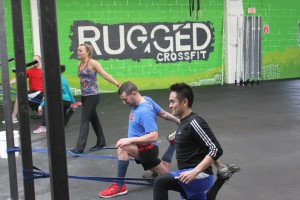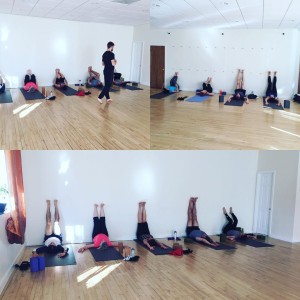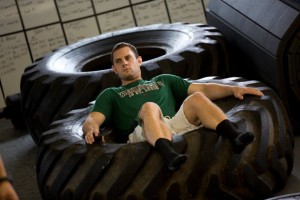Everyone who trains is usually looking for something different. Somebody might do it to counter their work lifestyle, like somebody who sits eight hours a day, five days a week. Someone else does it for competition, trying to achieve a personal best in either an endurance or weightlifting category. Another person might be doing it for general improved health and longevity of life. So although the concentrations are different, chances are each person wants to build and maintain muscle mass without losing joint mobility. That being said, each of these people will have to focus on tissue and joint health as well as tissue and joint functionality if they are going to improve.
Flexibility is usually associated with being a yogi or having been born with extremely lax tissues. Those of us who don’t have it think we can’t get it, and on the other-side of the coin, those of us who have it, think we’ve got it and don’t need to address it anymore. Being tight is associated with being a gym bro, someone who cares more about their biceps than their glutes, a meat head essentially. My problem with these misconceptions is that usually the person who is not flexible enough and the person who is overly flexible are both using ineffective approaches towards improving their flexibility or stability and bringing their bodies closer to center. And who could blame them? A lot of body coaches out there don’t know the first thing about how to bring somebody closer to flexibility, or dial them back away from hyper flexibility. Well, lets see if we can change that.
First know this- muscles do two things, they relax (think stretch) and they contract. A contraction can happen either concentrically or eccentrically (straighten your elbow to eccentrically contract the muscles and flex your elbow to concentrically contract the muscles). Eccentric action is when a muscle contracts in a long state, it lengthens itself, pulling the proximal part of the muscle belly distally towards each end of the joint it attaches to (think lengthening). A concentric action gets the muscle to pull the distal ends of the muscle bellies, at the joints, towards the proximal and central part of the muscle belly (think shortening). Secondly- muscles relax. So after they contract, they get a chance to relax and replenish (think stretch). Utilizing the idea of reciprocal inhibition, when we move, we want to be contracting muscles on one part of our body (ie; the anterior part of the body), while the posterior part relaxes, and visa versa.
Try a forward fold, keep your knees soft, and let your head roll down as you reach for the floor. In an ideal forward fold, your anterior chain would actually curl you down (contracting) so that your belly rests on your thighs and your posterior chain would relax and lengthen your palms to the floor. However, so many of us, due to either shortness or locked-long tissue on the posterior chain, have trouble with this basic flexibility movement. This is an example of reciprocal inhibition.
Lets go back to our two scenarios. We’ve got Johnny No Reach, he’s a tight worker-outer who can lift a lot of weight but cannot perform basic flexibility movements because of his tin-man like movement. And then in the other corner we’ve got Susie Sways A Lot, who can stack her body and contort herself in some impressive positions, but lacks stability of her joints due to her gumby ways. Both these people need to readdress their tissue and joint functionality. What I mean is, if Johnny and Susie plan on getting stronger and better without injury, they’ve got to develop a new plan for how to acquire the needed flexibility or stability in their body.
JOHNNY NO REACH
Johnny has overly contracted muscle tissue everywhere. And then the places he does have flexibility, chances are he’s developed locked-long patterns there to make himself feel better about the lack of his reach. Locked-long will forever be associated with a locked joint, which implies that a person has a default pattern of locking joints out to get somewhere they want to go. Something to note- a locked joint is a weak joint. Locking joints out as a default does not demonstrate stability or even strength of tendons, but rather overloads them with stress, unnecessary force, and jams bones into places they don’t like. It shuts off a neural-connection to the tissues that go to said joint and it develops a movement pattern that is inefficient and sub-obtimal for anybody looking for new length in their body. Johnny- (like half of the workout population) needs to improve his flexibility by focusing more on slow stretches using the proximal distal method. Basically what this method encourages is to stabalize your body proximally, in order to mobilize and lengthen tissues distally. Proximally is going to be the spine, his core, everything in his center region. It has to always stay straight, like a stick, and he needs to move his body in a controlled manner while maintaining spinal integrity.
SUSIE SWAYS A LOT
Susie has become a swooper and swayer, mainly because she figured out at a young age that she can show off by pushing her joints’ limits. She can essentially go to positions that most of us cannot, but it’s not that she controls herself into a deep lateral lunge or split, it’s that she can fall into it. Remember what we learned above, a locked joint is a weak joint. Susie’s nervous system has learned to flop her wherever she wants to go, but it isn’t a muscularly engaged position usually, it’s instead a way to go with gravity, and her body is coincidentally open enough to let her go there. I don’t want to be nit-picky and say, “hey this is a terrible thing,” but it can lead to joint dysfunction and injury if not addressed sooner than later. Susie will benefit from doing flexibility work with a softness in her joints, allowing the angle of each joint to change, thus bringing in new players to help stabilize her body in space. She’ll benefit more from stability work, like a 90/90 lunge with front heel elevated and back knee 3/4 of the way to the floor, than she will a deep long crescent lunge. But her objective (and the other half of the gym population) is to retrain her body to not swoop and sway so much, but to instead learn how to move herself with controlled tension.
So we’ve got our two polarities, and they make up most of the fitness world. Which one are you? Only you can tell. And you may be wondering what you can do to start to better address your tissue and joint health and functionality. For this reason I’ve laid out my favorite strategies for improving flexibility, mobility, and stability.
THE RULES OF THE GAME
1. Mobilize for a position, not a joint. Think about the position you’re uncomfortable in, and then figure out how to mobilize the joint in a position that is relative to the desired movement you’re creating.
2. Muscles pull, they don’t push. For that reason learn to move with controlled tension. I want you to move while you stretch. This will create reciprocal inhibition when done correctly. My yoga classes (not all yoga) are great for this. Never ‘rest’ when actively stretching, you need to be controlling the tension throughout your body as you move. The occasional resting position will let your muscles relax, but really you need to understand how to control tension throughout your muscular system during movement.
3. Find the muscle that is short and needs releasing, and release it first before you move. You want to work on the opposite side of the muscle that is restricted. So if hip extension is hard for you, your semi-hamstrings (semitendinosus and semimembraenosus) may need some lengthening, but first take out the slack by releasing (cross-frictioning) the rec fem in the front so you can get the length for the hammie and get pulled out of your tight hip flexion. No point in moving quickly in a workout if your semis are short and your rec fem is long. Talk to a body coach, lengthen what needs lengthening, cross-fiber what needs broadening. ***note: my above example is not the ONLY solution for someone struggling with hip extension, merely a circumstantial example ***
4. Stabilize the proximal area to increase range of motion in the distal part of the body. If you want your groin to let go, find a neutral spine and keep the spine neutral as you move in and out of some sort of dynamic stretch. If your core is not working to stabilize the spine, you will not get the desired result in the distal part of your body.
5. If you’re trying to open a joint up, use a band for distraction and move into the desired position (maintaing core, breath, and spinal integrity of course). If you’re trying to improve soft tissue function, foam roll, use a tennis or lacrosse ball, something more pressure point centric. If you’re looking for deeper neurological release and information or guidance on your body, reach out to a bodyworker who understands the intricacies of the body and ligament/tendon system.
6. Remember that the hips and shoulders are analogs of one another and considered the ‘4 knots’. If you start to unravel them, your body will naturally start to open up. Here is a tip for any athletes out there to better delineate your specific needs. Shoulder extension requires more medial rotation of the humerus, and shoulder flexion requires more lateral rotation. Hip extension needs medial femoral rotation whereas hip flexion requires lateral rotation. This seems overwhelming at first glance, but if you work with a knowledgeable coach, they’ll understand how to build your body in a way that addresses your specific needs.
Flexibility, mobility, and stability are important no matter who you are. And as you evolve as an athlete, your body will begin to request different types of focus. Having said that, if you can first figure out where you are, you’ll have a much easier time figuring out where you need to get to in order to become better balanced in your body. Johnny No Reach and Susie Sways A Lot both have some work to do, but that’s one of the beautiful things about the human body is that we have this ability to grow, change shape, and adapt to new circumstances. So get out there and start figuring out what you need most. Let your body do the guiding, and all you have to do is find a rule or two that works for you and apply it. Let me know how it goes and as usual reach out with any questions you might have!



